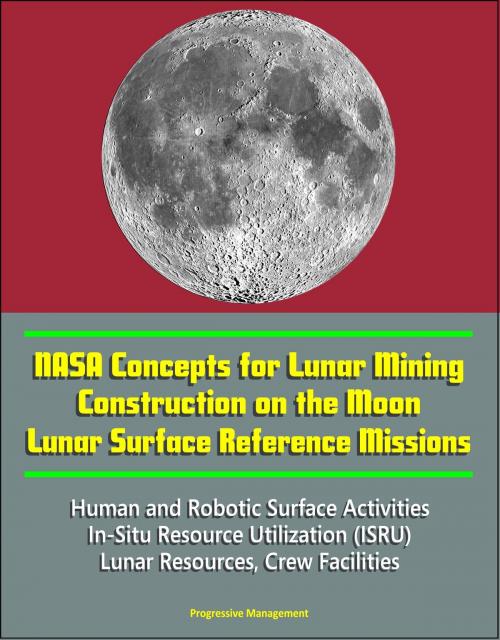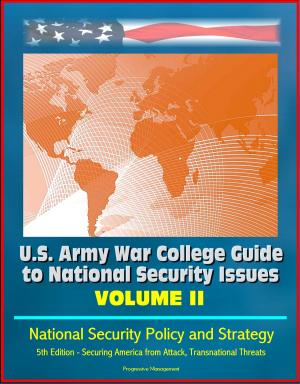NASA Concepts for Lunar Mining, Construction on the Moon, Lunar Surface Reference Missions, Human and Robotic Surface Activities, In-Situ Resource Utilization (ISRU), Lunar Resources, Crew Facilities
Nonfiction, Science & Nature, Technology, Aeronautics & Astronautics, Science, Physics, Astrophysics & Space Science| Author: | Progressive Management | ISBN: | 9781311535764 |
| Publisher: | Progressive Management | Publication: | August 28, 2014 |
| Imprint: | Smashwords Edition | Language: | English |
| Author: | Progressive Management |
| ISBN: | 9781311535764 |
| Publisher: | Progressive Management |
| Publication: | August 28, 2014 |
| Imprint: | Smashwords Edition |
| Language: | English |
Two official NASA internal documents - converted for accurate flowing-text ebook format reproduction - provide unique details of plans developed by NASA during the Constellation program era for human and robotic lunar surface activities, including the possibility of lunar mining and in-situ resource utilization (ISRU).
The first document is titled NASA Lunar Mining & Construction Activities and Plans. "One area NASA is developing that can significantly change how systems required for sustained human presence are designed and integrated, as well as potentially break our reliance on Earth supplied logistics, is In-Situ Resource Utilization (ISRU). ISRU, also known "living off the land", involves the extraction and processing of local resources into useful products. In particular, the ability to make propellants, life support consumables, fuel cell reagents, and radiation shielding can significantly reduce the cost, mass, and risk of sustained human activities beyond Earth. Also, the ability to modify the lunar landscape for safer landing, transfer of payloads from the lander an outpost, dust generation mitigation, and infrastructure placement and buildup are also extremely important for long-term lunar operations. While extra-terrestrial excavation, material handling and processing, and site preparation and construction may be new to NASA and other space agencies, there is extensive terrestrial hardware and commercial experience that can be leveraged. This paper will provide an overview of current NASA activities in lunar ISRU mining and construction and how terrestrial experience in these areas are important to achieving the goal of affordable and sustainable human exploration."
The second document is titled Lunar Surface Reference Missions - A Description of Human and Robotic Surface Activities. " The organization of this document begins with a description of several major objectives of renewed exploration of the Moon: (1) Scientific exploration; (2) Determining the suitability of the Moon as the basis for astronomical and other observations; (3) Developing technology and conducting tests relevant to long-term human stays on the Moon; (4) Developing technology and conducting tests of technical and human systems relevant to the human exploration of Mars and beyond; (5) Testing technologies and conducting investigations that can lead to economically beneficial activities on the moon; and (6) Understanding the conditions under which crew health, safety and performance and effective facility operations can be extended for long-duration missions. For each of these areas, the rationale for the activities, their scope and scale, how they might be accomplished, and the functions required to conduct them, are provided.
Many of the capabilities required to carry out the objectives are common between objectives, so they are presented and discussed in a section that describes major functional requirements, such as field investigations, mobility, sample analysis, teleoperations, and various crew functions. These are the functions that must be carried out on the lunar surface. Missions will be designed to allow some or all of these functions to be conducted to achieve specific mission objectives, which may differ from mission to mission.
Finally, scenarios are provided for two classes of missions: (1) a short-stay time mission, similar to Apollo, in which 4 astronauts spend four days on the lunar surface; and (2) a longer stay time mission, with the capability to support 4 people for 30 days on the Moon.
Two official NASA internal documents - converted for accurate flowing-text ebook format reproduction - provide unique details of plans developed by NASA during the Constellation program era for human and robotic lunar surface activities, including the possibility of lunar mining and in-situ resource utilization (ISRU).
The first document is titled NASA Lunar Mining & Construction Activities and Plans. "One area NASA is developing that can significantly change how systems required for sustained human presence are designed and integrated, as well as potentially break our reliance on Earth supplied logistics, is In-Situ Resource Utilization (ISRU). ISRU, also known "living off the land", involves the extraction and processing of local resources into useful products. In particular, the ability to make propellants, life support consumables, fuel cell reagents, and radiation shielding can significantly reduce the cost, mass, and risk of sustained human activities beyond Earth. Also, the ability to modify the lunar landscape for safer landing, transfer of payloads from the lander an outpost, dust generation mitigation, and infrastructure placement and buildup are also extremely important for long-term lunar operations. While extra-terrestrial excavation, material handling and processing, and site preparation and construction may be new to NASA and other space agencies, there is extensive terrestrial hardware and commercial experience that can be leveraged. This paper will provide an overview of current NASA activities in lunar ISRU mining and construction and how terrestrial experience in these areas are important to achieving the goal of affordable and sustainable human exploration."
The second document is titled Lunar Surface Reference Missions - A Description of Human and Robotic Surface Activities. " The organization of this document begins with a description of several major objectives of renewed exploration of the Moon: (1) Scientific exploration; (2) Determining the suitability of the Moon as the basis for astronomical and other observations; (3) Developing technology and conducting tests relevant to long-term human stays on the Moon; (4) Developing technology and conducting tests of technical and human systems relevant to the human exploration of Mars and beyond; (5) Testing technologies and conducting investigations that can lead to economically beneficial activities on the moon; and (6) Understanding the conditions under which crew health, safety and performance and effective facility operations can be extended for long-duration missions. For each of these areas, the rationale for the activities, their scope and scale, how they might be accomplished, and the functions required to conduct them, are provided.
Many of the capabilities required to carry out the objectives are common between objectives, so they are presented and discussed in a section that describes major functional requirements, such as field investigations, mobility, sample analysis, teleoperations, and various crew functions. These are the functions that must be carried out on the lunar surface. Missions will be designed to allow some or all of these functions to be conducted to achieve specific mission objectives, which may differ from mission to mission.
Finally, scenarios are provided for two classes of missions: (1) a short-stay time mission, similar to Apollo, in which 4 astronauts spend four days on the lunar surface; and (2) a longer stay time mission, with the capability to support 4 people for 30 days on the Moon.















